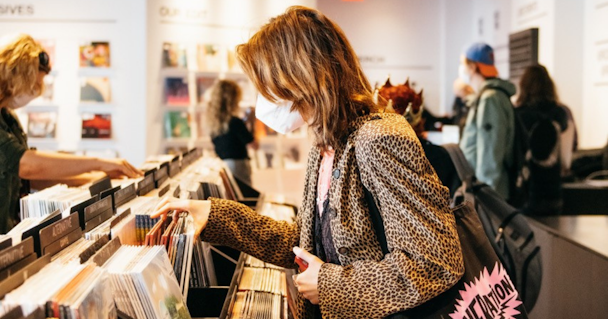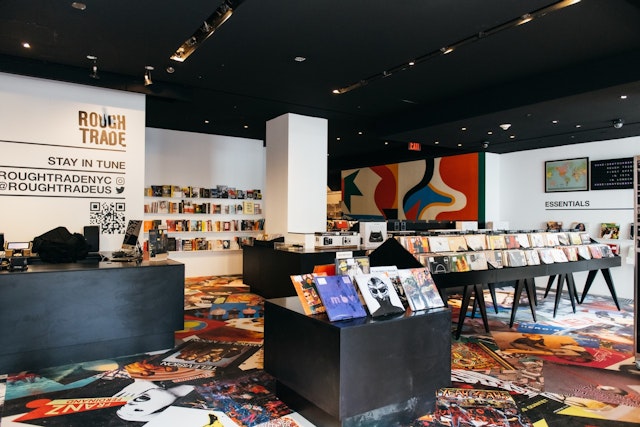
Advertisement

A customer browses records at Rough Trade's NYC location
With the popularity of vinyl records still going strong, Rough Trade has moved its New York store from Brooklyn to the crowded streets of midtown Manhattan. As part of The Drum’s Retail Deep Dive, we explore whether it can it reach a broader audience while keeping its precious indie image intact.
One of the quirks of the contemporary music industry is the enduring popularity of vinyl records. Despite streaming – and when we talk about music streaming, we’re almost always talking about Spotify, which enjoys double the market share of its next competitor, Apple – having long displaced physical media as the dominant form of music consumption, the vinyl comeback is still going strong.
That trend has enabled Rough Trade, the record brand and recording label, to expand beyond Britain in recent years. In 2013, it opened Rough Trade NYC in the heart of hipster Williamsburg.
Why then has the company shuttered its Brooklyn location in favor of a Manhattan pitch in the Rockefeller building? And can it court a larger crowd while keeping its indie image?
Rough Trade co-owner and US managing director Stephen Godfroy tells The Drum: ”We think midtown is in need of a counterculture influence – and Manhattan lacked a record store.”
He says the move is about accessing a bigger market – and Williamsburg was just too far away from the crowds to attract significant footfall.
”It remained the nights-and-weekends neighborhood. We had really popular weekends, but we weren’t so busy during weekdays. And we felt somewhat isolated, because even though the demand for vinyl has been surging for the last decade... we were not connecting to as broad and as diverse an audience as we possibly could if we were located somewhere with busy foot traffic seven days a week.”
In contrast, retail space at the Rockefeller Centre, an iconic part of the New York skyline, will help Rough Trade reach far more shoppers.
”This opportunity was too good to resist: it would enable us to open in a location that would defy convention and be initially controversial, but in the longer term, it’s a platform that enables us to reach a wider audience, a more diverse audience, and take what we do day-to-day in terms of championing really exciting new artists to a new level.”

The location also offers a better opportunity to build a destination store worthy of record collector pilgrims. ”The key ingredients are great records and great staff,” Godfroy says.
Rough Trade kept on its entire staff from Williamsburg, either on the shopfloor or at a distribution center built out of the old Brooklyn location – an addition which will in turn expand the company’s ability to meet online demand.
While the new store won’t be as large as the Williamsburg branch, a repurposed warehouse with its own performance space, the store has access to two stages on the Rockefeller ’campus’ – its outdoor plaza and the iconic Rainbow Room.
”To program live performances there with the type of artists that we represent is unprecedented and hugely exciting for us and for the label community that we represent.”
Staff-led curation will also remain a mainstay at its new NYC store. ”Our recommendation authority comes from 45 years of selling records over the counter, face-to-face to people, and being this interface between artists, community and audience. That enables us to be able to select these records and recommend them with confidence.”
The combination of intimate gigs, expert curation and stock that appeals to the whole of indie music culture, rather than just record collectors, will help Rough Trade NYC put itself on the map.
”If it’s a good record store, it’s not a smash-and-grab retail experience. The dwell time for shoppers tends to be a lot longer... we reflect that with great coffee, live performances, great beer. You have the scope to have a broader offer than just the music itself,” he says.
In the long run, Godfroy says streaming need not be a threat to businesses like Rough Trade. He suggests vinyl’s own revival stems, at least in part, from the adoption of streaming.
”They’re complimentary in their respective attributes. A low-friction cost enables you to discover music very easily. However, it puts into sharp relief the added value you get from actually owning a record. You truly cherish the recordings that you really love... the LP is the definitive audio document.”
As it expands in the US, it’ll draw on its legacy and brand recognition. Could a bigger enterprise endanger perceptions of Rough Trade?
”Rough Trade is a bit of a freak, to be honest. It’s not like any other retailer in the music space. It has history, it has a brand... it’s not just one store and that does enable us to achieve things that other independent retailers can’t. Yet at the same time, we’re not a chain retailer.”
Godfroy says the company has to be precious about partnerships with other brands and careful not to lessen the value of its brand. ”The brand is representative of independence, of independent thinking. So it’s very important that we maintain that founding ethos 45 years later. But from a brand management point of view, we look to protect its integrity.”
Images provided by the Rockefeller Center.